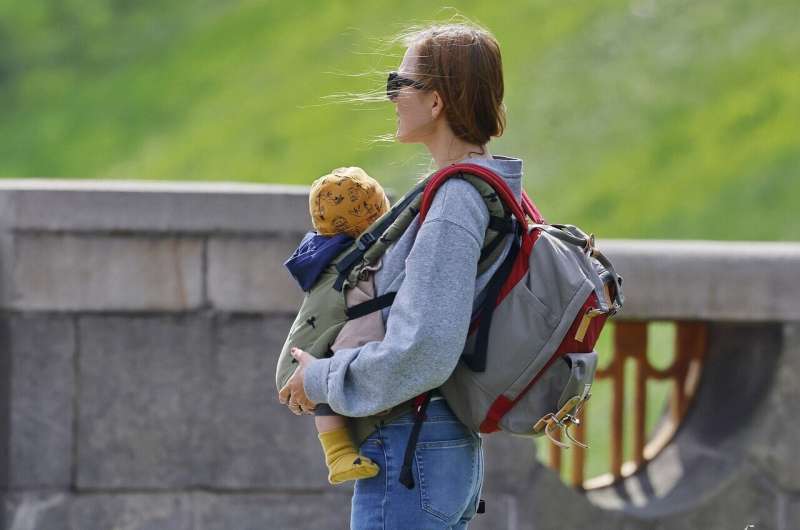Babies trigger adults to spot threats faster and judge dangers more harshly

Lisa Lock
scientific editor

Andrew Zinin
lead editor

In a potentially threatening situation, the world looks more dangerous when caring for a baby, finds first-of-its-kind Cornell psychology research using virtual environments to explore parenting dynamics.
When playing an online game that placed an adult on the side of a road after running out of gas, both parents and nonparents were quicker to detect oncoming traffic, and rated cars as moving faster, when they had to keep a virtual baby out of harm's way. Reactions were quicker when looking after a crawling infant than a dog or a toy robot.
The studies suggest infants' appearance and movements lead adults to interpret sensory information differently, which supports babies' safety and learning, the researchers said. This automatic behavior likely evolved because humans are a slowly developing (altricial) species, with infants who become able to move and explore long before they have the cognitive capacities to stay safe while doing so.
"It's not a question of multitasking that caused these adults to perceive the cars as moving faster or to see them as more dangerous—it was having the baby there," said Michael Goldstein, professor in the Department of Psychology and the College of Arts and Sciences, and director of the Behavioral Analysis of Beginning Years (B.A.B.Y.) Laboratory. "It's not so much that parents hold the baby closer, but that they perceive the world as more threatening, in a way that causes them to reinterpret what they're seeing."
Goldstein is the co-author of "The Dynamics of Perception in Caregiving: How Infants Change the Way We See the World," Aug. 26 in Child Development. The first author is Emma Murrugarra, Ph.D. '25, now a researcher at the New Jersey Institute of Technology.
The research represents a new approach to studying parenting, Goldstein said, which has primarily relied on questionnaires and categorizations of parenting styles, such as authoritarian or permissive. By introducing virtual environments with a standardized baby, the B.A.B.Y. Lab aims to analyze caregivers' moment-to-moment behavior in more realistic situations—much as other animals have been studied.
"Studies of the mechanisms underlying human parenting, in my view, are way behind studies of parenting in other species," Goldstein said. "We're trying to capture how parenting works in seconds and milliseconds, and we're seeing it operate at the level of perception."
In a pair of experiments, the online game-players scored points for flagging down cars that appeared at random intervals, traveling between 30 and 70 mph. The first study, including 65 parents and 31 nonparents, introduced a stationary, crawling or walking baby that players could pick up if it moved too close to the road—but while doing so, they might not see approaching cars. In the second study (16 parents, 21 nonparents), players might be responsible for a crawling baby, a mutt or a mobile robot.
Goldstein was surprised initially by how similarly parents and nonparents behaved, but upon reflection, said it made sense that anyone in an alloparental species would react quickly to protect another's child. He said it's possible more effects of caregiving experience could emerge in less threatening situations, which his lab is also studying.
"It's not about having attitudes about yourself as a parent—there's no time for that in this paradigm," Goldstein said. "It's this very automatic process of seeing the world as more threatening. Parenting seems to be happening at a low level of perception and action, rather than high-level attitudes and attributions we make, which is mostly how it has been studied."
The researchers also observed women reacting faster than men, suggesting a possible gender difference. Goldstein said that effect merits further investigation, but could also be due to the study sample including more women who were primary caregivers.
The research adds to a body of B.A.B.Y. Lab work that has challenged assumptions in the field that slowly developing babies must be born with some innate understanding of the world to stay safe. Instead, Goldstein said, caregivers instinctively provide safety that enables infants to explore and learn.
"Evolution has shaped adults to have an automatic and deep understanding of what it takes to keep a baby safe and provide information for that baby," Goldstein said. "This is fast, unconscious behavior, and that's a hint that there are deep biological mechanisms at work here. Babies don't care what you think, they care what you do. If you had to stop and think about it, kids would be in a lot more danger, right?"
More information: Emma Murrugarra et al, The Dynamics of Perception in Caregiving: How Infants Change the Way We See the World, Child Development (2025).
Journal information: Child Development
Provided by Cornell University
















